They strangle attention. Ride one down the street and watch as babies point and smile mid-whimper, dogs chase joyfully, angsty teens fight the curling in the corners of their mouths, old biker types in leather nod with supreme comprehension. There are countless combinations of weapons-grade speed, sex, beauty, design and freedom found between two tires, sure — but these fifty-one, specifically, are the icons hand-picked by Gear Patrol as our favorites of all time.
They are equal parts simple and complex, a mechanical interpretation of form meeting function with attitude to spare. Whether it’s chrome glimmering in the sun, the artful engineering behind a single-sided swingarm or their ability to outrun just about anything, motorcycles are more than just simple transportation.
>
Standards
Basic and Better for It
Honda Super Cub
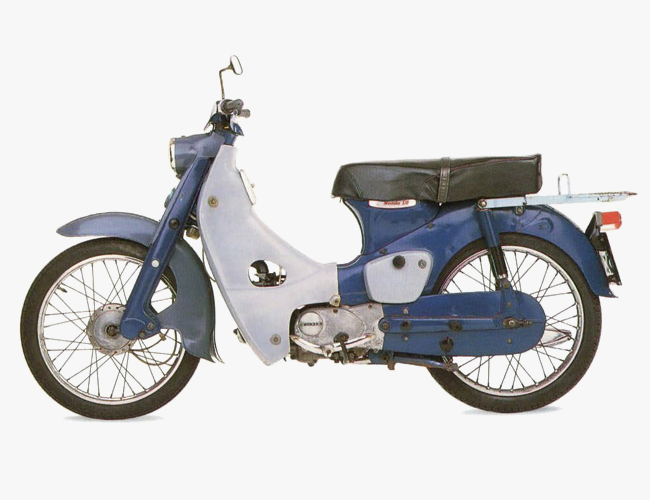
The Honda Super Cub is the most popular selling motorcycle in the world. A 55-year production will do that. So will a bulletproof single-cylinder engine and a low cost of ownership. Found everywhere throughout Asia, Africa and South America and available in multiple iterations, the Super Cub has been compared to the Ford Model-T and Volkswagen Beetle for its influence on motorized transportation. The Cub is currently produced in fifteen countries around the world and won’t be disappearing anytime soon — to help celebrate its 50th anniversary, Honda churned out its 60 millionth unit.
Learn More: Here
Honda CB77
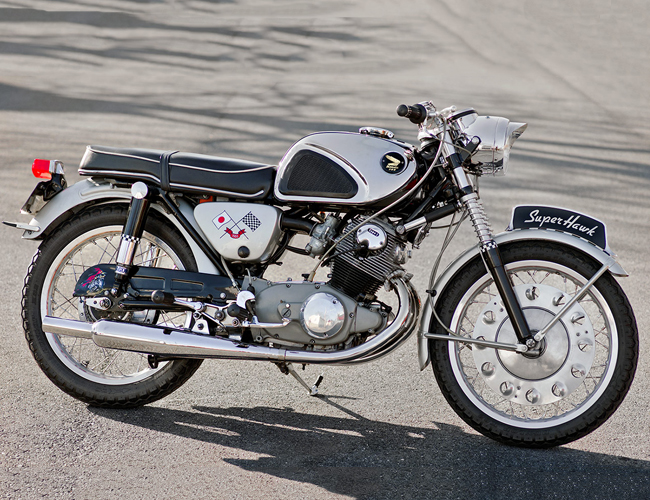
Photo: Petrolicious
The CB77, or Superhawk, is sportbike genesis for Honda. The 305cc parallel twin powering the CB77 could freely rev to nine grand and easily send riders over the ton (100 MPH) set by the British big twins. It was the Honda’s reliability, however, that established and cemented the Japanese manufacturer’s reputation in the Western world. The frame was crafted out of tubular steel rather than pressed, with the motor doubling duty as a stressed member, thereby shedding precious pounds and making the CB77 incredibly flickable. The Honda Superhawk is also the ride of preference for Robert Pirsig during his philosophical journey documented in Zen and the Art of Motorcycle Maintenance.
Learn More: Here
Triumph Bonneville
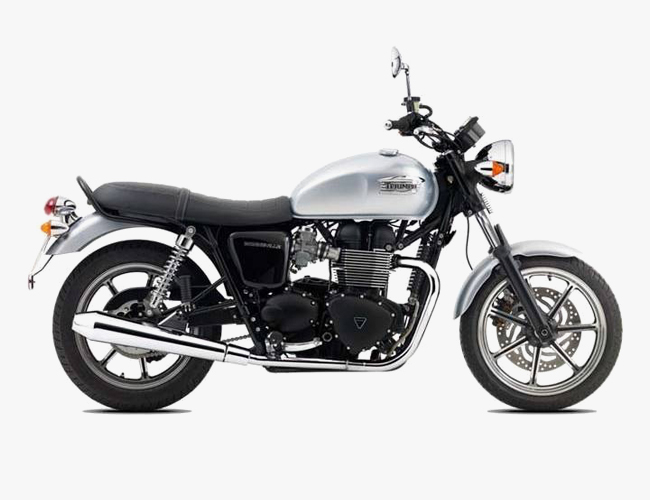
Icons cannot be killed. Production of Triumph motorcycles has ceased three times and yet the Bonneville thrives. Whether it’s an early Triumph Engineering effort, a Norton Villiers Triton, a Devon Bonnie or a new model from Hinckley, the Bonneville oozes cool from every angle. Brando, Dean and, of course, McQueen have all swung legs over this plucky Brit, escalating a status originally earned at the track. Its parallel-twin engine has grown from 650cc to 865cc and carburetors have given way to injection, but its silhouette remains as constant as our desire to be seen riding one.
Learn More: Here
Honda CB750
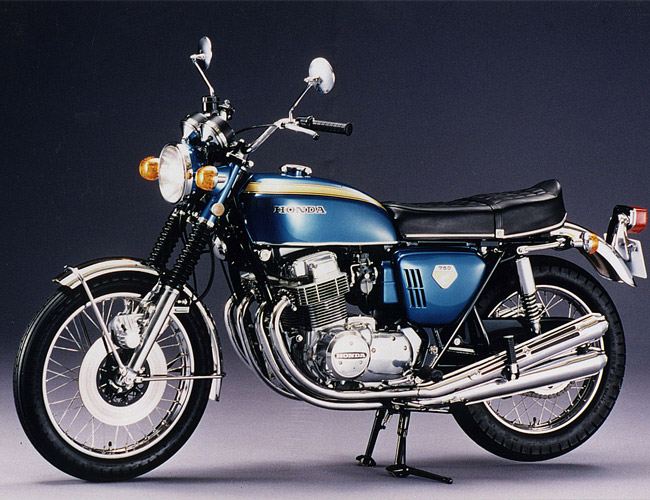
In 1969, Honda introduced the masses to the transverse-mounted, inline-four cylinder engine. Credited as being one of the first true “superbikes”, the CB750 was the game-changing result of Soichiro Honda’s obsession with cracking the American market. Delivering incredible bang for the buck, the CB750 could smoothly and comfortably top 120 MPH thanks to its race proven inline-four layout. Front-mounted disc brakes were another mainstream first that revolutionized the motorcycle market. An electric start, a kill switch, the use of an overhead camshaft and easy maintenance were the icing on the cake.
Learn More: Here
Kawasaki Z1
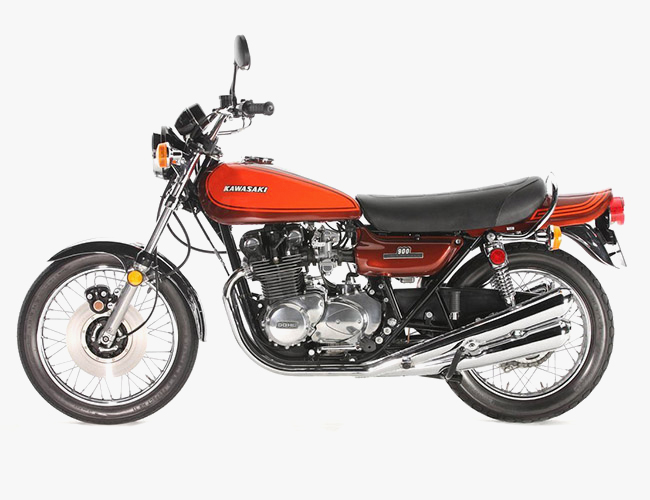
Known internally as project “T103” and “New York Steak”, the Z1 was Kawasaki’s bigger, faster answer to Honda’s CB750. In fact, when Honda revealed their iconic CB in 1968, Kawasaki scrapped their almost ready for prime-time 750cc effort and declared a power war on the superbike world. When it finally hit the showroom floor in 1973, the big Kwack 903 cc was the most powerful Japanese 4-pot ever produced. Its 82 hp output was enough to propel the 550-pound superbike to 130 MPH and take home the coveted “Machine of the Year” award from The Motorcycle News for four consecutive years. The Z1 would also rack up numerous wins at the track — a close partnership with Yoshimura tuning and a gentleman by the name of Paul Smart in the saddle made them the team to beat in the mid-seventies.
Learn More: Here
Harley-Davidson XR750
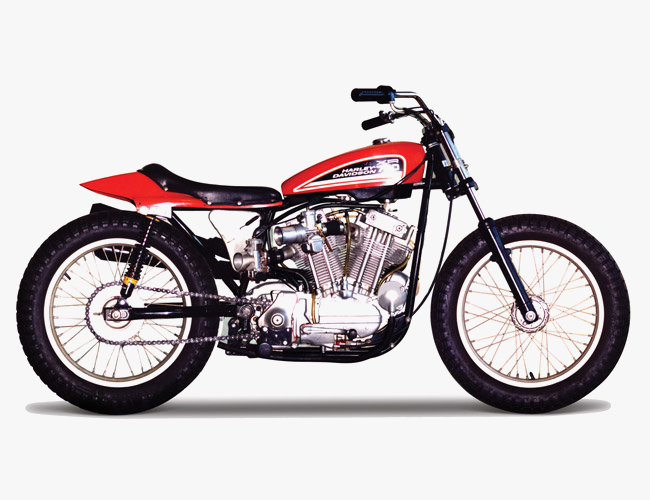
Essentially a parts-bin special slapped together to meet changing AMA dirt-track rules, the XR750 is an example of the whole being greater than the sum of its parts. After years of domination, Harley’s racing department were forced to completely rethink their efforts for the 1970 season. So in under a year they did — and in doing so created the winningest race bike in the history of the AMA. Thankfully, homologation rules stipulated that 200 race-ready road-goers be made available to the public; a legend was born. A man named Evel only added to the allure of the XR750 when he made it his bike of choice.
Learn More: Here
Kawasaki Triple
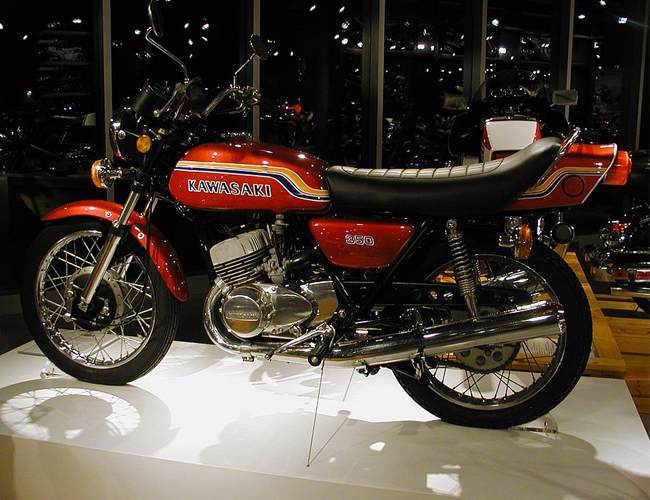
The Kawasaki Triples cranked out during the disco era were renowned for their incredible power-to-weight ratio. Sub-13 second quarter-mile runs could be hammered out within two blocks of the showroom floor. That was, provided they were in a straight line and riders could keep the front wheel on the ground — the torquey, free-revving 3-cylinder engine was notorious for wanting to run up on one. Poor handling plagued them from word go, even when the front wheel was touching tarmac, and they would go on to become dubbed the “Widowmaker” of the 1970s. Despite this, or maybe because of it, Kawasaki Triples are sought out to this day, commanding hefty premiums when you can find them.
Learn More: Here
Cafe Racers
Vintage Speed Machines
BSA Goldstar Clubman
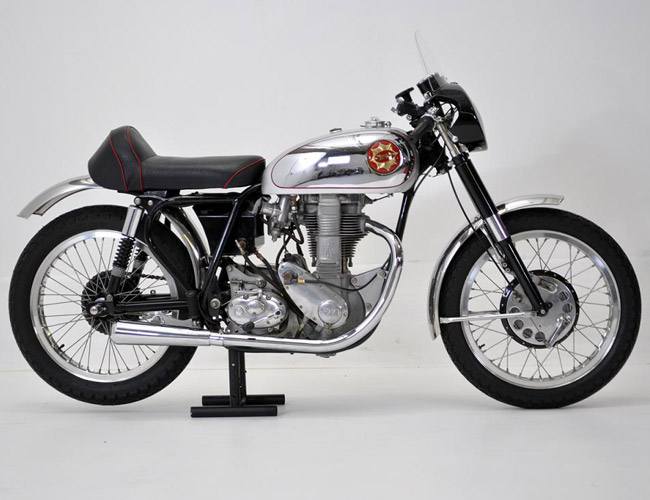
The Gold Star was a pin awarded to riders able to lap the Brooklands circuit at an average speed north of 100 MPH. In 1937 Wal Handley came out of retirement, hopped on a BSA, recorded a lap speed of 107.5 mph and the BSA Goldstar was born. To back the new nomenclature now emblazoned on their tanks, BSA dedicated their efforts and dominated the Clubman TT up until it ended in 1956. The 500cc single-cylinder Goldstar was hand assembled and sold with factory test results alerting owners to the horsepower they would sidle. Later models could even be optioned with a first gear capable of hitting 60 before shifting was necessary. This led the factory catalogues to indicate that this bike was a racer first and foremost and not suitable for road use. Thankfully, this would only made them more popular.
Learn More: Here
Moto Guzzi LeMans
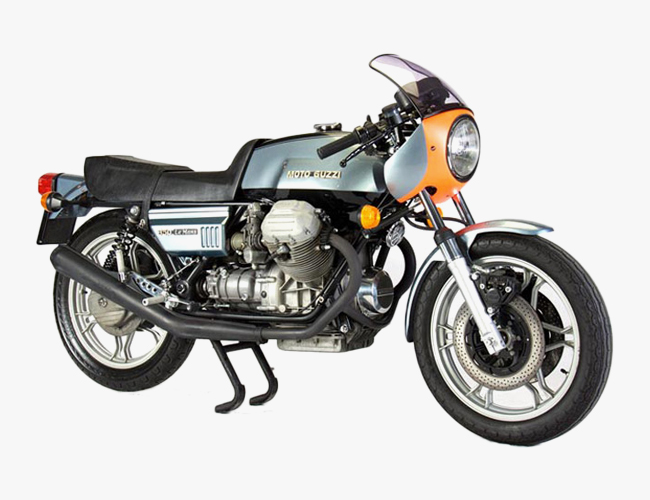
Powered by a low-tech lump mated to a car-type transmission, the shaft-driven Moto Guzzi LeMans often felt like two different animals. Lethargic and twitchy at low revs, the bike had serious frame twisting when riders got on the throttle — making corner exists a dicey affair. On the right road though, with your knees being sucked into the carbs at full bore, this Latin lovely transforms into something sublime. Matte black plumbing took the place of chrome and complemented the sculpted tank and low-lying windscreen to give the Guzzi its trademark cafe racer stance that is often imitated on lesser bikes today.
Learn More: Here
Norton Commando
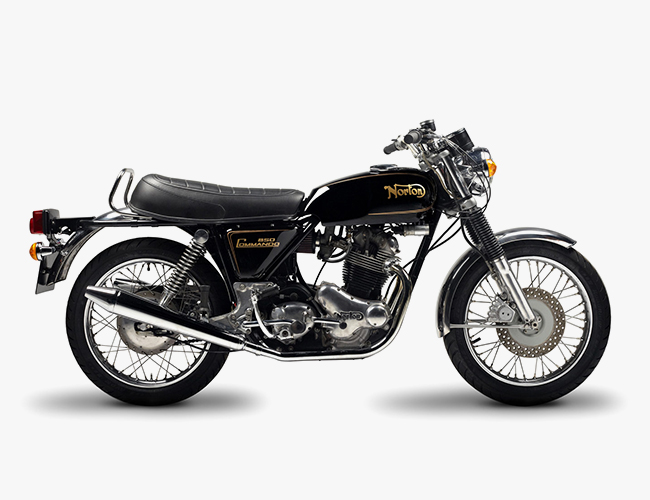
So successful were the Norton Commando race bikes that the term “unapproachable Norton” was coined in pit row. Interestingly though, what made the Nortons so tough on the track was how approachable they actually were. Taking what Triumph had started with the Speed Twin, Norton employed a former Rolls-Royce engineer to develop a package for the larger 750cc Norton parallel-twin. The revolutionary use of rubber mounting for the mechanicals meant that the vibrations inherent with high strung twins at speed was all but eliminated. Riders could now push harder for much longer stints. It also meant riders would often go for broke — early Nortons were famous for leaking a bit of oil here and there, but we’re pretty sure they were just sweating horsepower.
Learn More: Here
Ducati 900SS
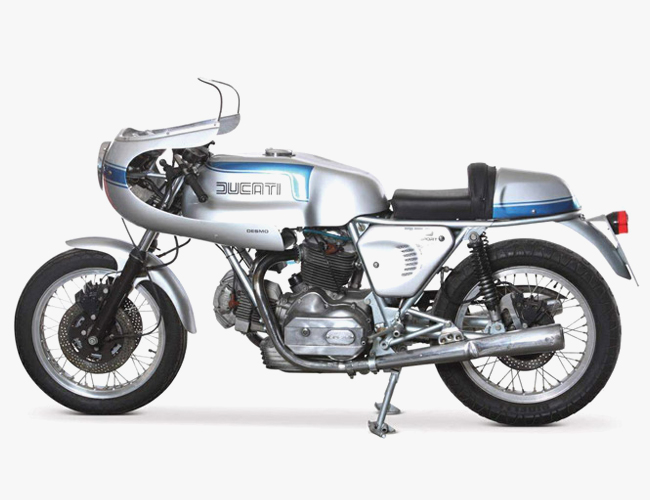
Hungry to nibble at the Japanese-dominated supersport market of the ’70s, Ducati developed the 864cc “square case” powered 900 Super Sport. Resembling the formidable 750 SS that Paul Smart rode to victory in Imola, the bigger Desmodromic L-twin was an immediate success. Ducatisti regard the 1978 model as the most desirable iteration, with its redesigned shifter (now on the left side of the bike) and its classic spoked wheels. The ‘78 model would also win the prestigious Isle of Man TT before bowing out gracefully at the top of its class.
Learn More: Here
1950 Norton Manx
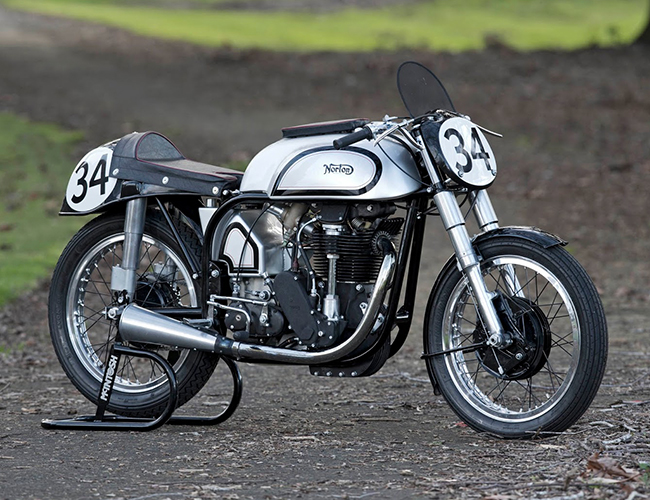
Norton motorcycles and the Isle of Man TT go together like strawberries and Devon Cream. Having competed in every Tourist Trophy race since its inception (1907), Norton made the race their raison d’etre. In 1950, the team was working with an antiquated and underpowered package — the engine was a variation on a 25-year-old design. The “Featherbed” frame featured a fully welded duplex frame and pivoted rear fork suspension setup, instantly reducing weight and exponentially improving handling. Add to that some minor tweaks to find an extra 8 hp (for 36 hp in total), and it was no longer just about winning for Norton. They secured 5 of the top 6 finishes.
Learn More: Here
Ducati PS1000LE
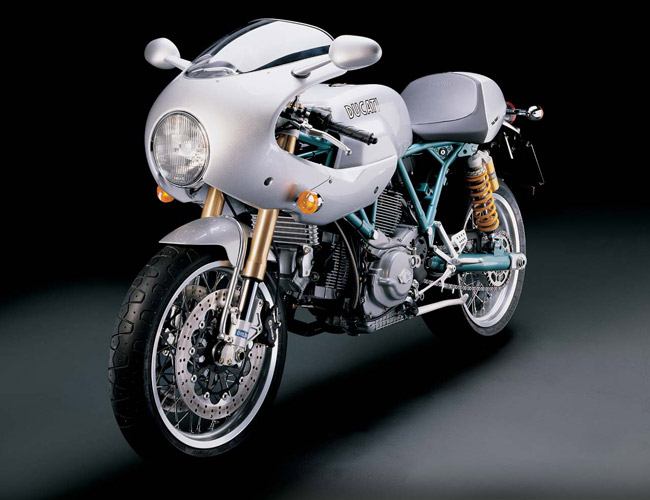
Built to commemorate Paul Smart’s first place finish in Imola on his 1972 Ducati 750SS, the Ducati PS1000LE is the prettiest possible way to pay anyone respect. Built around their Sport Classic series, the Paul Smart model took Pierre Terblanche’s design to a new level. The bubble-shield front fairing, wire spoked wheels and green trellis frame create a classic juxtaposition with the ultra modern Ohlins suspension and beefy Pirelli tires. Available in limited numbers, and only for a single year, the PS1000LE may prove to be one of the most collectible Ducatis ever made.
Learn More: Here
Classics
Old-School Style
Brough Superior SS100
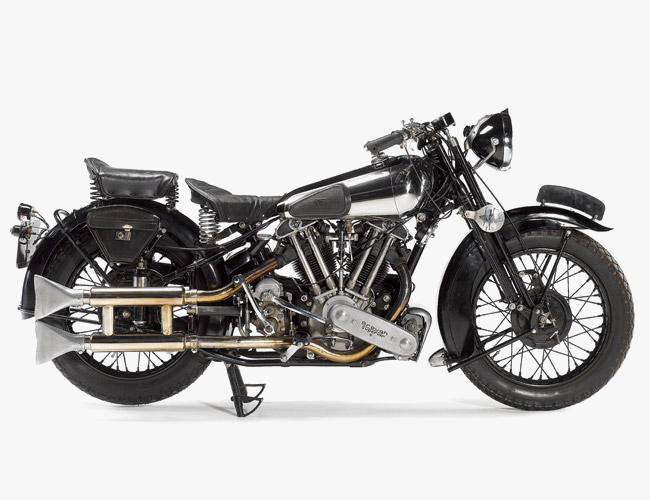
So exacting was the individual tailoring of each Brough Superior SS100 that they gained explicit permission to be dubbed the “Rolls-Royce of motorcycles”. A marvel of craftsmanship and engineering, each SS100 was guaranteed to hit 100 MPH — no great feat by today’s standards, but this was in 1924. By 1928, the Brough Superior SS100 would hit 130 MPH in the standing kilometer with George Brough in the saddle. T.E. Lawrence, better known as Lawrence of Arabia, owned three Brough Superiors in his life and famously died due to head injuries sustained when swerving to avoid two young cyclists. Lawrence’s death would eventually lead to the requisite use of crash helmets for motorcyclists.
Learn More: Here
Royal Enfield Bullet
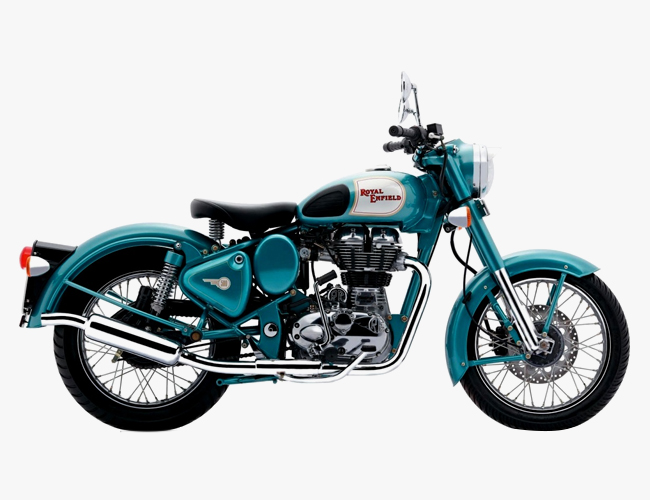
The Royal Enfield Bullet currently enjoys the world’s longest production run with 83 years under its fenders. That alone warrants iconic recognition. The first Bullet was fired in the land of Tea ‘n Crumpets in 1931 and featured an overhead valve, single-cylinder 350cc motor that soon found itself enlisted for the British Army and Royal Air Force. The simple design and surefooted performance that earned the Bullet’s stripes at war also made it a mainstay for civilian duties. Production has since moved offshore to India, but the Bullet remains virtually unchanged: “Made like a gun, goes like a bullet”.
Learn More: Here
1940 Indian Chief
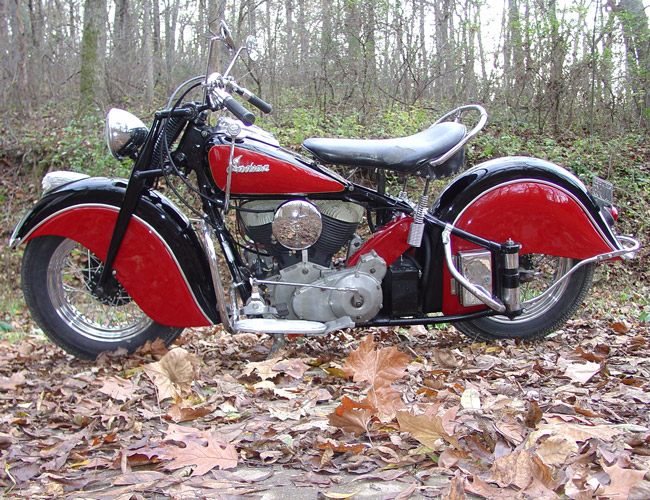
Crafted for the first time with a sprung frame, the ‘40 Indian Chief perked ears by easily outperforming Milwaukee’s finest with regard to ride and handling. It was, however the debut of Indian’s trademark fenders that really set tongues wagging. More than simple slices of steel, the flowing skirted fenders found on the Chief gave the bike an immediate stance and presence that was — no, is — undeniably gorgeous. Now, sixty years after the last true Chief rolled off the line, a new breed is ready to hit the road… And from what we hear, they aren’t half bad, either.
Learn More: Here
1937 Triumph Speed Twin
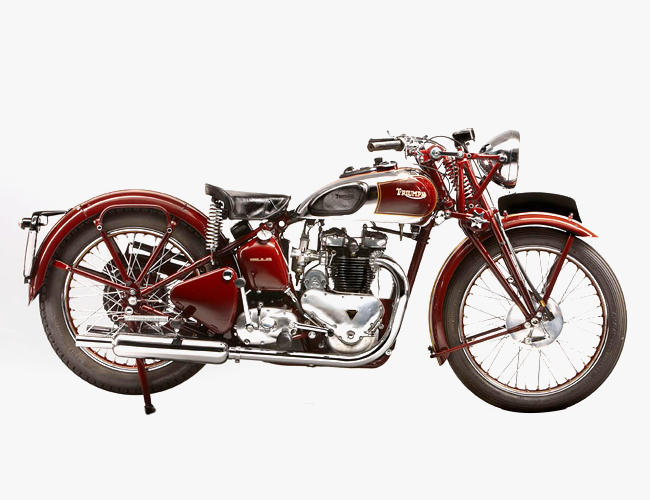
Edward Turner’s Triumph Speed Twin could be one of the most influential motorcycles ever designed. The 500cc parallel-twin packed more power into a package that was lighter and narrower than the current crop of single-cylinder thumpers. Within a decade, a version of this engine could be found in every competitor’s model. The gold pinstriping and Amaranth red paint of the original made the mechanicals shine while the fuel tank design set a standard that remains today. The bike that ensured Triumph’s survival after World War II would eventually evolve into that other icon on our list, the Bonneville. The dog’s bollocks, indeed.
Learn More: Here
1923 BMW R32
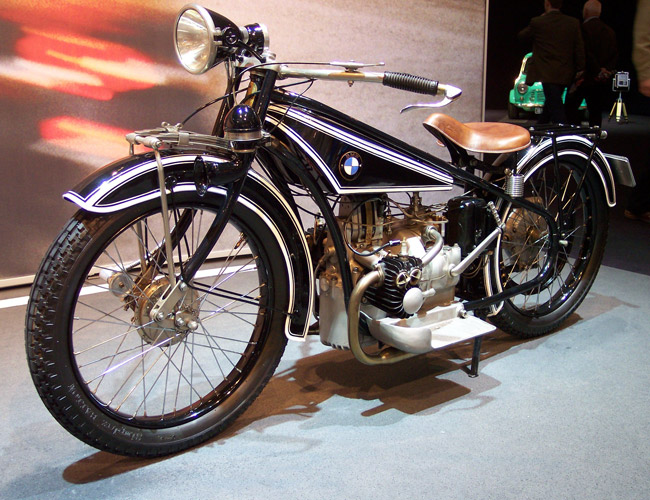
After the war, German aircraft manufacturing was grounded and BMW found themselves in search of purpose. Five years before they would begin building Ultimate Driving Machines, Bayerische Motoren Werke would build motorcycles. In 1923, engineer Max Friz designed what would go on to epitomize BMW Motorrad: The R32. Powered by a boxer-twin engine, the horizontally opposed heads were ideally located in the airstream to increase cooling. This combined with the use of a drive shaft all but eliminated the common motorcycling issues associated with putting power to the pavement. This drivetrain arrangement would be used exclusively at BMW until its first chain drive effort in 1993 and is still prominent today on all of its boxer bikes.
Learn More: Here
FN Four
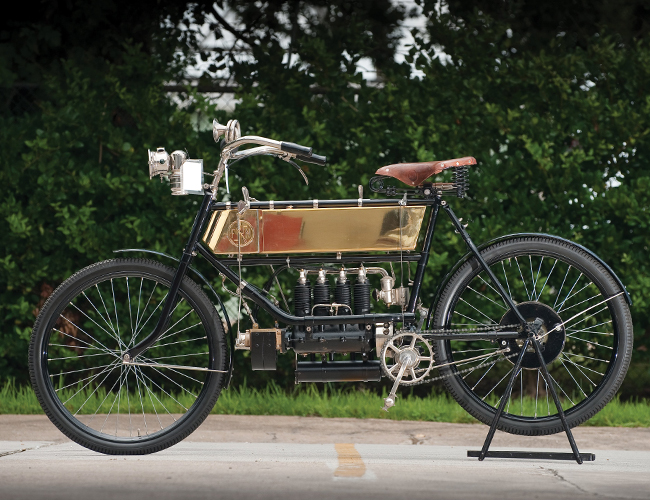
Like most European marques, FN began life as a munitions manufacturer before turning to two wheels. Unlike the single and two-pot efforts of their contemporaries, FN would introduce the world to the first bike powered by an inline-4 cylinder engine. At its debut in 1905, the 362cc FN Four offered a riding experience unmatched by its less-pistoned brethren: where single cylinders and twins of all contrivances were rough and buzzy at speed, FN’s inline-4 was smooth and almost vibrationless. This easy operation lead to immediate growth in popularity, ccs and horsepower. Strangely, this engine arrangement did not translate to wins at the track for the Belgian innovators, despite its unparalleled success there today.
Learn More: Here
Ariel Square Four
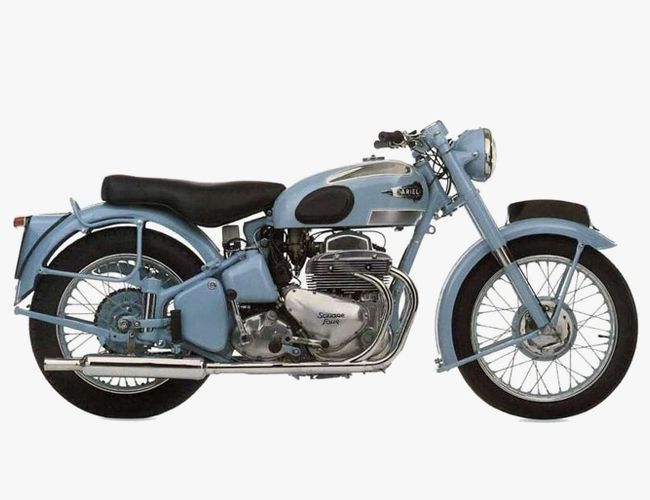
Prior to revolutionizing British big-twins at Triumph, Edward Turner developed an incredible new concept for a four-cylinder motor. A monobloc of two parallel-twins grafted together that shared a common crankshaft, the Square Four engine was unlike anything before it. Most bike makers scoffed, save a tiny Birmingham-based bike builder, Ariel. The Ariel Square Four used a 4-speed constant mesh transmission with a suicide shift; it was bragged that the transmission allowed the bike to accelerate from 10 to 100 MPH in top gear. This was incorrect. The early models would struggle to hit 90 and would stalled under 13 MPH in fourth. It would take Ariel over 20 years, an additional 500ccs and two more exhaust pipes to get their unique approach to finally “run the ton”, yet it remains a marvel of engineering worth celebrating.
Learn More: Here
BMW R60/2
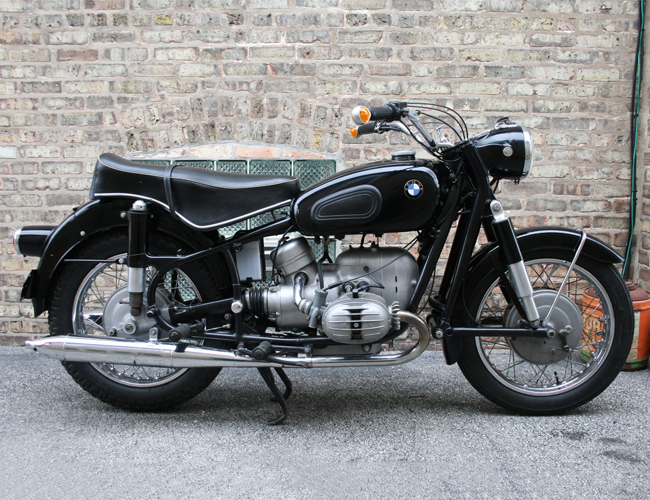
Photo: Motonit
On the market for thirteen years, the R60 was BMW’s go anywhere, do anything tourer of the 1960s. Originally designed for sidecar duty, the combination of a punchy flat twin and an Earle’s fork design made it an incredibly capable bike both on- and off-road. So formidable was the R60 that rider Danny Liska took his beautiful black beast for a 95,000 mile ride from the Arctic Circle to the tip of South America. Then he decided to pave the way for Boorman and McGregor and made the trek from Northern Europe to the Cape of Good Hope in South Africa — without a support team, satellite phone, GPS or any foreign fixers.
Learn More: Here
Vincent Black Shadow
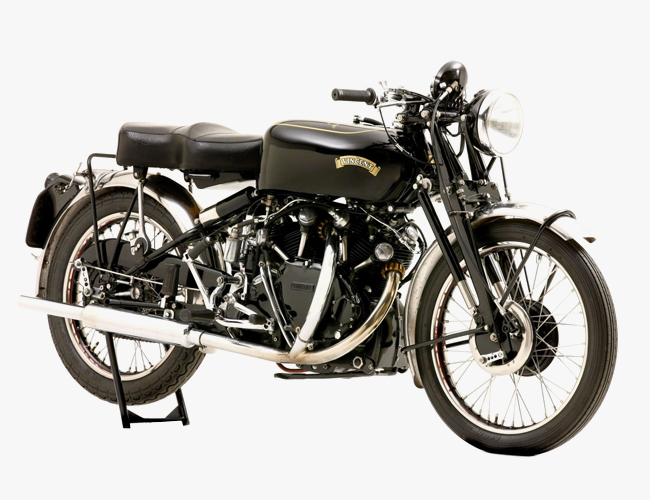
Photo: Moto USA
Hunter S. Thompson once remarked that “if you rode the Black Shadow at top speed for any length of time, you would almost certainly die.” The 50-degree V-twin was completely baked in black enamel and produced enough grunt to carry riders to 125 MPH in an era where the 100 MPH benchmark was barely attainable. The Vincent employed extensive amounts of aluminum throughout, and its motor hung from the cross-bar, acting as a stressed member. This kept weight down to 450 pounds, which meant the Vincent Black Shadow would balance a see-saw with contemporary 500cc singles. Innovative front forks, a four-speed transmission and finned brakes at both front and rear rounded out a package widely regarded as the world’s first superbike.
Learn More: Here
Cruisers
In It for the Long Haul
Harley Davidson Sportster
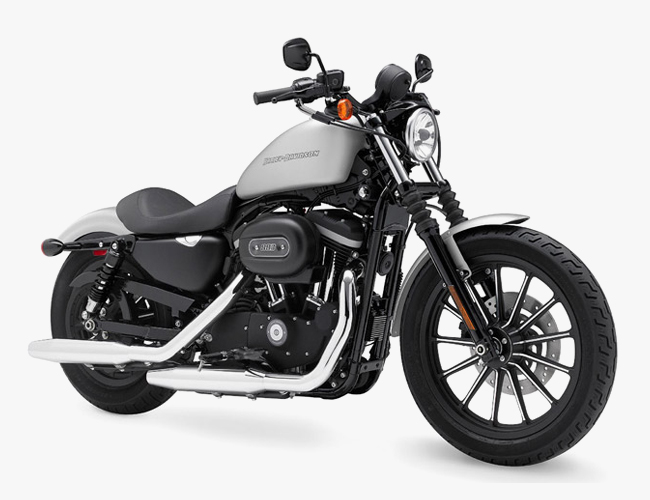
The Sportster is the best selling bike branded with the Bar and Shield and has been on the market since 1957. Originally intended for flat-track racing, the fast and nimble Sporty found favor with riders seeking speed over the comforts usually afforded by Milwaukee’s finest. Harley Davidson has smartly done very little with the Sportster recipe. Power has always come in the form of a 45-degree V-Twin which was, until 2004, rigidly mounted to deliver its signature responsive ride. With a factory-forged variant to suit almost every style (five different versions are currently available) and Harley’s typically limitless catalogue of bolt-ons, the success of the Sportster should keep thundering on.
Learn More: Here
Honda Gold Wing
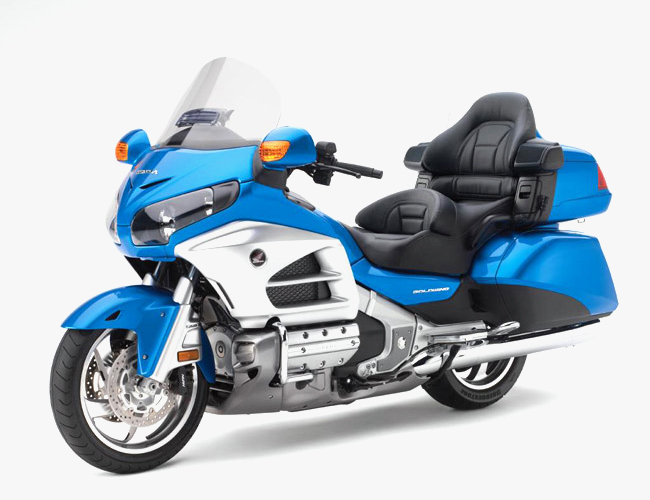
You may not believe that the Honda Gold Wing started life without fairings or saddlebags, but it did. Since its spartan beginnings, however, the Gold Wing has gone on to become one of the most luxuriously appointed and recognizable bikes in the world. Integrated GPS, heated seats (front and rear), airbags and even a reverse gear can be optioned to create the ultimate in on-road comfort. Powered by a 1.8-liter flat-six and tipping the scales at just under 1,000 pounds, the big Honda is surprisingly agile and swallows interstates like Joey Chestnut does hotdogs. Over one million Gold Wings were assembled during its thirty-year run in Marysville, Ohio before production moved back to Japan in 2012.
Learn More: Here
Confederate R131 Fighter
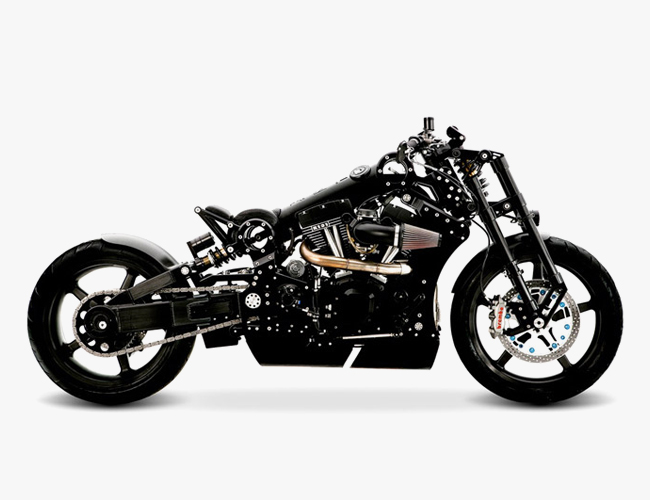
The designers at Confederate Motorcycles don’t mess around. Straddling the line between kinetic sculptures and mechanized, apocalyptic “horses”, their bikes are what Satan would ride if he had the balls. Case in point, the Confederate R131 Fighter. In-house milled Aircraft grade 6061 aluminum abounds, along with carbon fiber wheels and a carbon/ceramic/aluminum matrix compound for the brakes to hammer home that function dictates form. A huge 2.1-liter, thumping V-twin is used to push a mere 460 pounds in the Fighter, meaning it will undoubtedly pack a punch. With an extremely limited production run and pricing at just over $100k, we may want to start being nicer to the devil.
Learn More: Here
2002 Harley-Davidson VRSCA (V Rod)
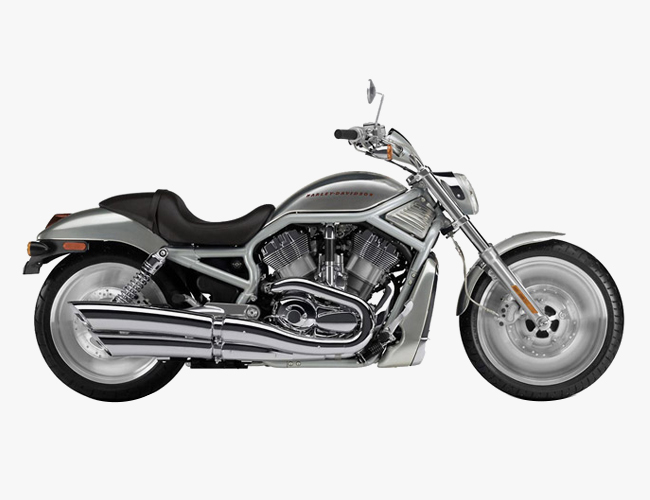
Harley-Davidson’s decision to buck 99 years of tradition and turn to liquid-cooled technology for the V-Rod was met with mixed reviews. Some embraced the forward thinking and extra grunt that rad’s afforded while others scowled and kept on keepin’ on. In our eyes, the V-Rod looks like a muscle-bound thug in a sharkskin suit, and it has the power to back it up. The Revolution engine was developed in conjunction with Porsche (another traditionally air-cooled aficionado) to develop a whopping 115 horsepower, enough to make it the most powerful H-D to date. Sadly it still polarizes the public and hasn’t enjoyed the success it deserves. Haters gonna hate.
Learn More: Here
Harley-Davidson WL
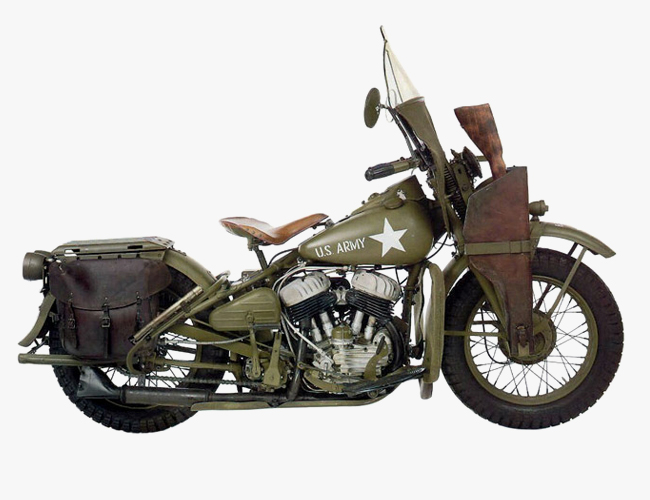
Harley Davidson is synonymous with the V-Twin engine. Knuckleheads, Panheads and Shovelheads: all of them are early iterations of the Motor Company’s continued dedication to the ubiquitous 45-degree power plant. But it was their Flathead-powered WL bike that cemented the Bar and Shield’s cultural status, both at home and abroad. As Harley’s contribution to World War II, the WL saw some 90,000 bikes enlisted for American field duty alone. Canadians, Brits, South Africans and even Russian soldiers would come to know and love the WL; many wanted to take them home after their tour. This onslaught of freshly discharged Hogs is responsible for the massive expansion in motorcycle culture that America (and the rest of world) would continuously embrace and revere for the next 75 years. Thanks, Harley.
Learn More: Here
Harley-Davidson ElectraGlide
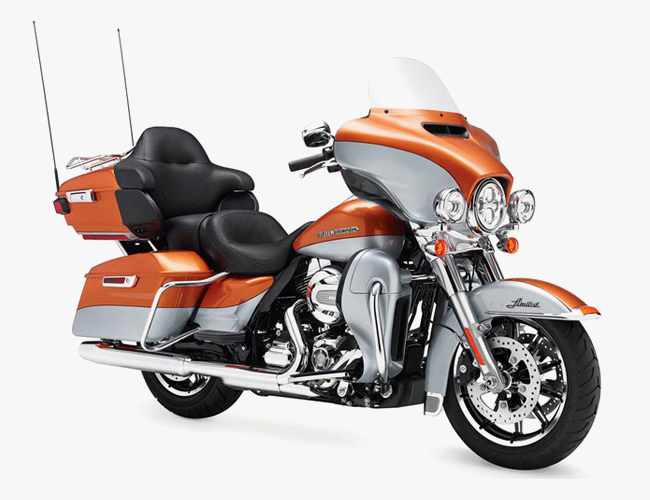
Most easily identified by the “Batwing” fork-mounted fairing adopted in 1969, the Harley-Davidson ElectraGlide has long been the domestic machine of choice for riders wanting to inhale interstates. Big, brash and boasting comfort for two, Milwaukee’s big-twin has always put rider comfort first, while packing enough luggage space to ensure riders need not dress like they so often do. Forty-eight years, four engines and countless miles later, the new Electra Glide will be Harley’s first tourer to feature twin liquid cooling, electronically-linked brakes with ABS and a touch-screen infotainment system. Born to be wild, indeed.
Learn More: Here
Yamaha Vmax
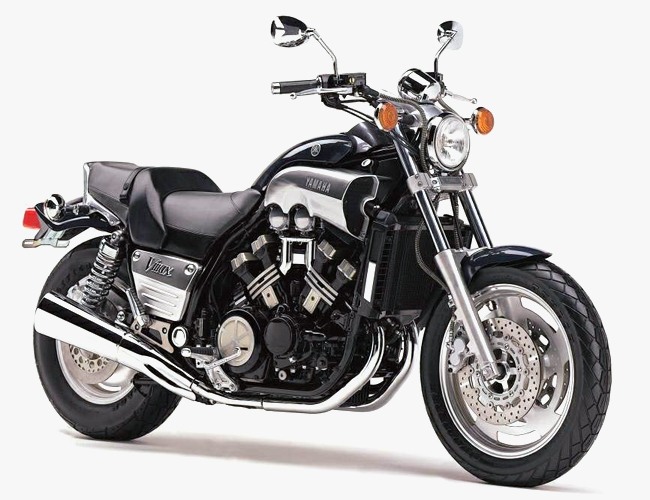
The intake plenums on the Yamaha V-Max are large enough to suck back small mammals. They have to be to feed the fury of the 1.2l V-four engine that powers this brute. The V-Max garnered nearly instant praise following its release in 1985, taking home Bike of the Year honors for its custom cruiser looks and lightning fast acceleration. Cornering has always been a bit of an achilles heel for the V-Max, but nobody seemed to care — the road always opens up eventually.
Learn More: Here
Honda Shadow VT1100
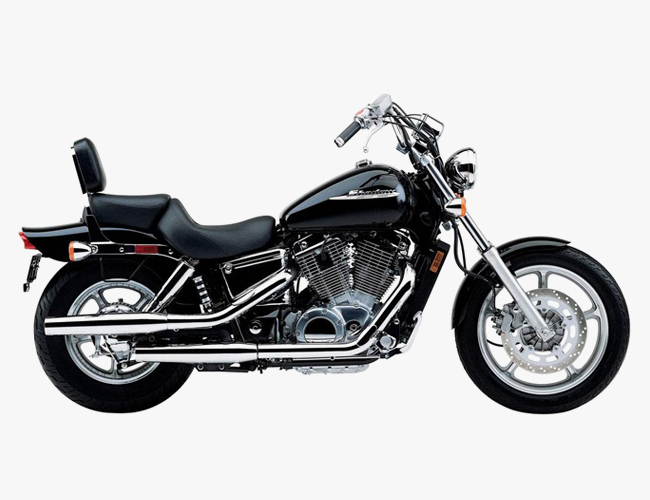
Visions of a low-slung gunfighter seat, retro styling and torquey V-twin usually set tongues wagging about Milwaukee. The Honda Shadow VT1100 may have aped the Wide Glide’s good looks, but its shaft drive and off-key exhaust note are a dead giveaway. Honda’s engineers worked long and hard to make sure the top of the Shadow family heap would give reason for pause amongst potential Harley buyers — and in the process created a cult following of their very own.
Learn More: Here
Honda Rune
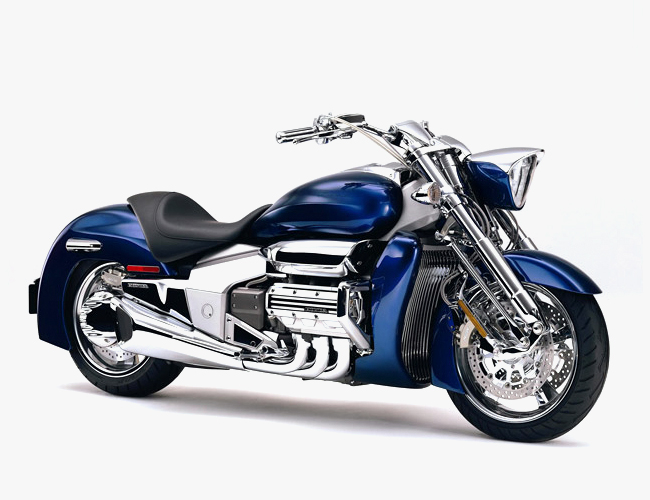
The Honda Rune is an example of that rare occasion when accountants aren’t invited to a product development meeting. At 69 inches between contact patches, the Rune was huge — and in the Candy Black Cherry color scheme, beautiful too. From a distance it could even be confused with Dodge’s ludicrous Viper-powered Tomahawk concept. Most impressive was the innovative trailing bottom-link front suspension. A first for a bike of the Rune’s size, it translated to road feel like that of a sport bike, prompting riders to make the most of the 1.8l boxer-six engine thrumming beneath them.
Learn More: Here
Adventure
Go Anywhere
BMW R1200GS
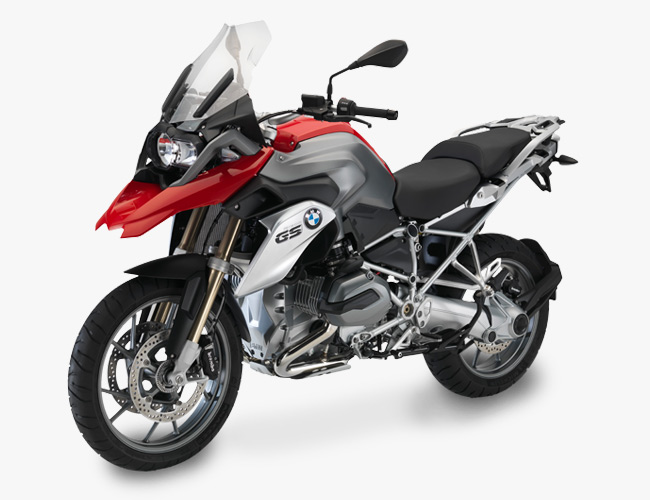
The BMW R1200GS was designed to handle any terrain. Long travel suspension, wide, flat foot-pegs and an upright seating position mated to BMW’s punchy boxer twin combine to create the ultimate getaway tool — this is the swiss army knife of bikes. It’s also the Motorad division’s best seller. Ewan and Charlie may have helped move some extra metal, but BMW’s GS bikes have long been a favorite for riders of paths less traveled. This potential alone makes it a bucket-list bike for most of us around the office, and its take-no-prisoners looks don’t hurt either.
Learn More: Here
KTM 950 Adventure
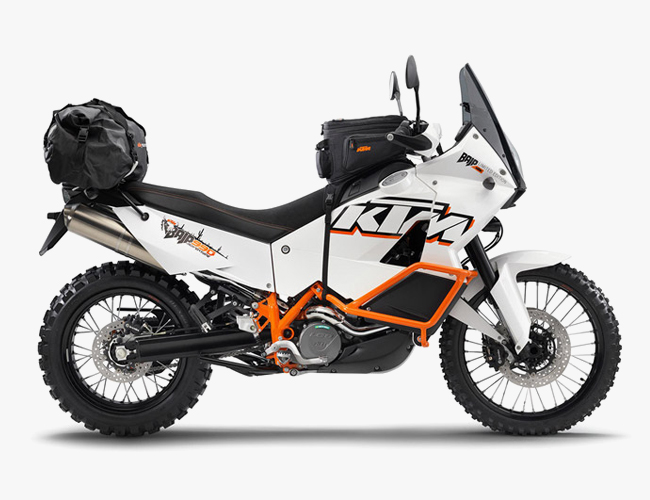
Austrians are an exacting bunch. Ten years of research and development were devoted to the KTM 950 Adventure. Before their dual-sport was given the final green light, it had already been tortured in Tunisia and had brought home a win at the Rallye des Pharaons. Its long suspension travel, featherweight frame and angular bodywork beg to play in the dirt. The all-new 75-degree V-twin packed enough twist and shout (72 lb-ft, 102 hp) to make mountains into molehills and devour everything in between. It’s not unheard of for KTM 950 Adventure riders to log over 100,000 miles in all types of terrain. Hell, we even like the color.
Learn More: Here
Honda Africa Twin
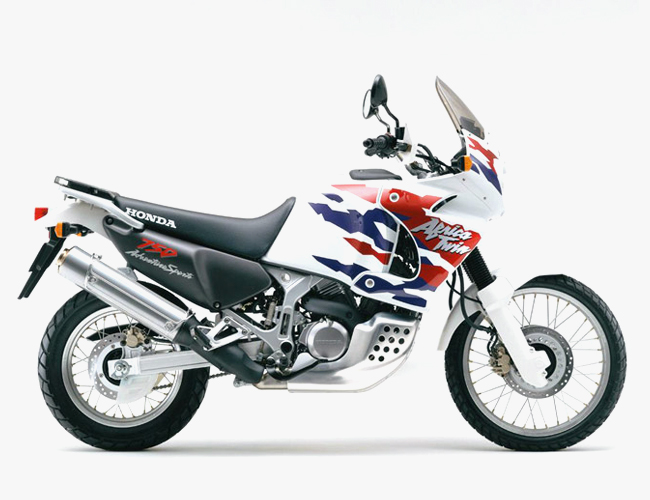
Originally billed as an homage to their Paris-Dakar-winning NXR-750, the Honda Africa Twin (XRV750) was more than a simple tribute. The long-travel suspension, integrated hand guards and beefy skid plates were enough to make average riders consider the run, and the bike’s 750cc V-twin was a proven performer. Both off-road and on, the Africa twin was incredibly capable and extremely comfortable. A tall and slender windscreen shields riders from sandstorms and interstate debris alike, and a wide flat seat offered numerous positions to slide into for optimal balance. Aluminum grab-rails served double duty as luggage racks when ditching it all for a couple of weeks; a Dakar-esque trip computer ensured you didn’t get too far off the reservation.
Learn More: Here
Sport Bikes
Riding Nirvana
Ducati Monster
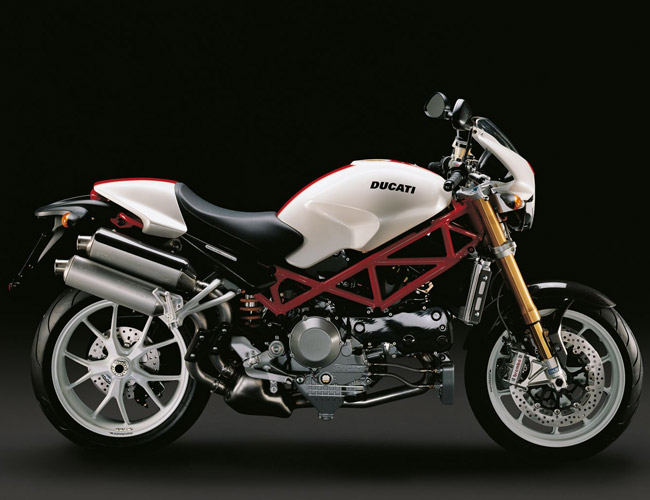
Not content to solely cause drooling with their fully faired offerings, Ducati decided to get naked with the Monster. Originally intended as an effort to give Bar and Shield buyers a different destination for deposits, Ducati inadvertently created a whole new segment. Twenty years of production later and the Italian marque has put more sultry nudes within the grasp of mere mortals than Hefner and Google combined. The Testastretta-powered S4RS is the most lust-worthy in our eyes. And much like every Playmate since 1953, the Monster’s most recognizable assets have remained constant and in full view since their debut; the exposed and slender trellis frame, aggressive yet welcoming stance and European allure all combine to deliver a complete package that anyone would be pleased to call his own.
Learn More: Here
Kawasaki EX500 (Ninja)
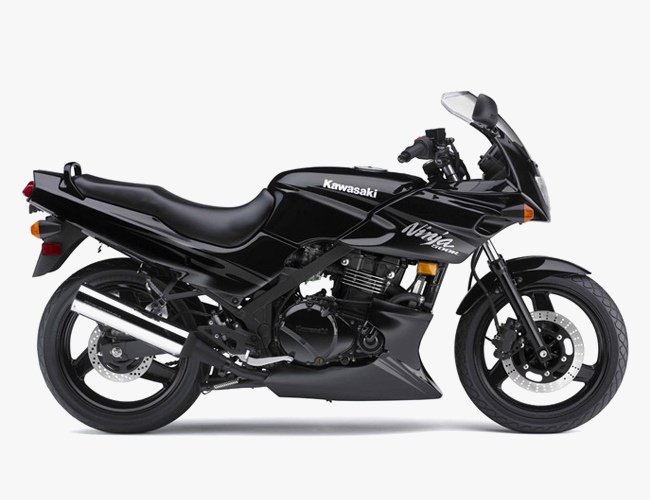
Crotch-rocket looks and gutsy performance in an inexpensive, rider-friendly package: this is the Kawasaki EX500. An easy choice for new riders and veterans alike, the entry level Ninja even spawned its own racing class that still clips apexes today. The 498cc parallel-twin developed a broad and usable powerband to propel the bikini-faired Ninja into a market of its own. Comfortable ergonomics, a wide, flat seat and amazing fuel economy meant long days on the road were a relatively painless affair; it even had a six-speed transmission. Sadly, this little Ninja disappeared in 2009 — undoubtedly to avenge a master’s death.
Learn More: Here
Gilera CX
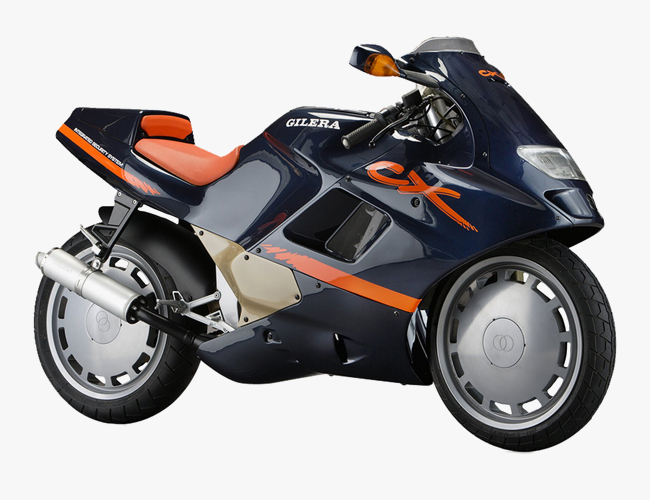
Approach the Gilera CX from its right side and you’d swear it was floating on solid, spun-steel wheels; that was very much the point. Drag coefficiency is often denoted using C over X, and Federico Martini’s inspired work when penning this Gilera is its mechanical interpretation. Everything about the CX’s styling evokes speed. The long, flat nose leading the slippery bodywork, the single-sided rear swingarm and that ingenious Paioli front suspension system along with tapered mirrors finish the job. A 125cc two-stroke engine hides behind the plastics and revs freely to 12,000 rpm while your chin rests on top of the 45mm alien looking suspension cap and you whoosh to over 100 MPH. Ciao bella!
Learn More: Here
1987 Honda CBR600F
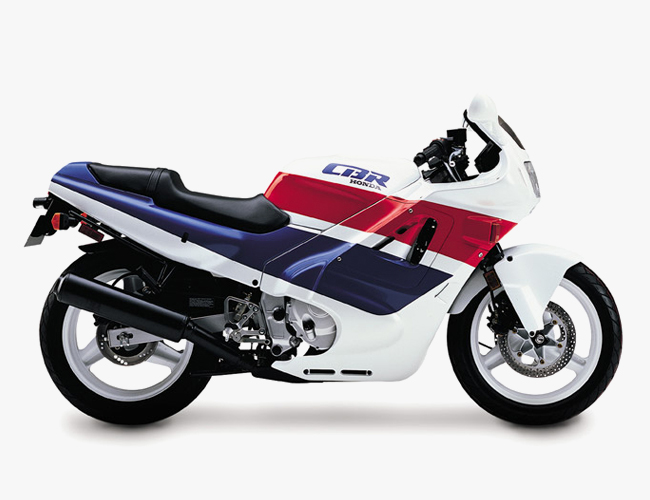
Better known in North America as the Hurricane, the CBR600F was Honda’s first sportbike to come wrapped in full plastics. Powered by an 85 hp inline-4, this new breed of sportbike was instrumental in developing the worldwide “crotch-rocket” market. Able to rev freely to 11,000 rpm and peak at 140 MPH with riders comfortably tucked behind its tiny windscreen, the Honda CBR600F was essentially a racer for the everyman. An immediate sales success, the CBR600F evolved over the years to deliver increased gobs of power from the same 600cc displacement. Honda’s keen awareness of rider ergonomics in their fully-faired sport bikes is what set them apart with the original Hurricane, and it remains a constant corporate philosophy to this day.
Learn More: Here
2007 Aprilia SXV
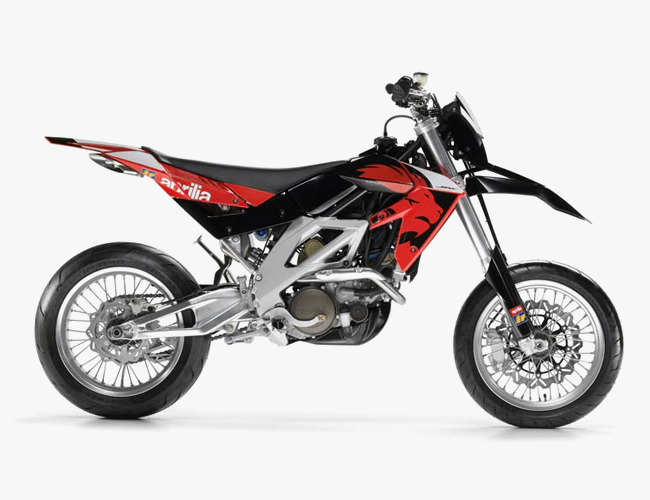
While the concept of a supermoto-type motorcycle has existed in the minds and garages of off-roaders forever, the Aprilia SXV is credited as the bike that brought it all home. Essentially a dirt-bike with street shoes, the SXV introduced the masses to the wonderfully sideways world of supermoto. It’s dirt-track racing on asphalt, and it’s beautiful: corners drifted with an inside heel clipping the apex rather than a knee, all while bars are twisted to full opposite lock. On the road, the powerful and light Aprilia is well-mannered and easy to ride, further fostering its following of enthusiasts and commuters alike.
Learn More: Here
Suzuki RG500
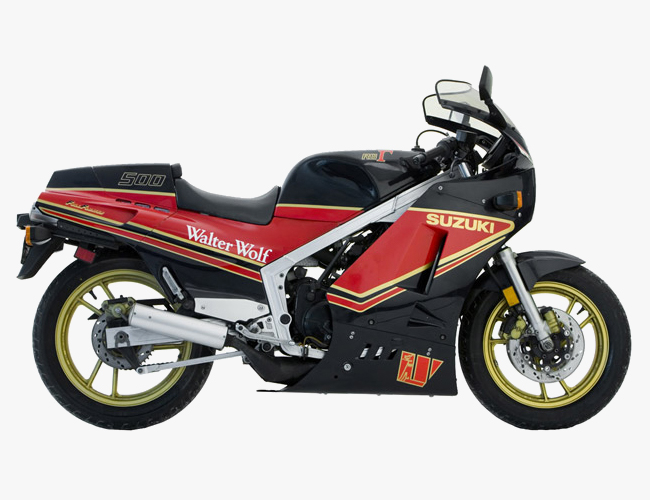
In the mid-eighties motorcycle development was spurred by a power struggle spilling over from the track. The Suzuki RG500 “Gamma” featured a two-stroke, twin-crank, square-four powerplant that epitomized the insanity hitting public streets. Smoking and crackling along, the 500cc Suzi had 94 hp on tap and, since every stroke was a power-stroke, could spin its tire through four gears. The Gamma also carved corners with aplomb, using a POSI-DAMP suspension system up front to smooth out nose dives under braking and encourage late-brake lean in. The two-stroke engine has all but belched its last smokey breathe, but for a time in the mid-eighties, Suzuki was cranking out one to be reckoned with.
Learn More: Here
Honda VFR750
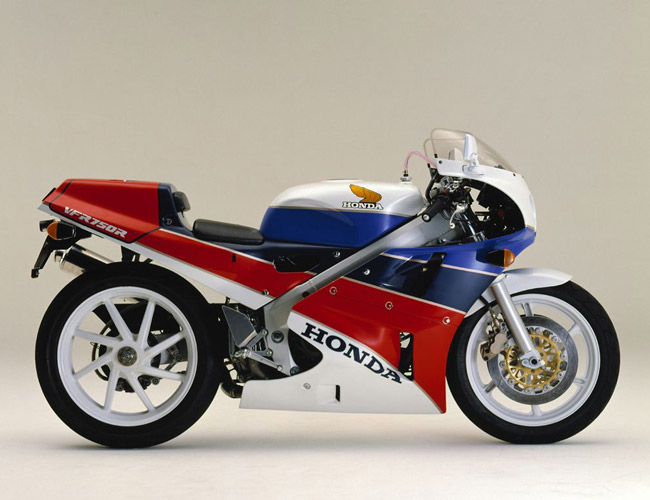
Long before Tamburini penned the divine Ducati 916 Honda had already integrated a race-proven single-sided swingarm design for streetriders to admire. The 1990 Honda VFR750, or Interceptor as it was known, was the third generation of Honda’s V-four sportbikes and is responsible for delivering an ideal balance of aggression and comfort. A direct descendant of the RC30 racer and powered by the engine of its replacement, the RC45, Honda’s Interceptor was extremely fast and flickable when carving corners. Its relaxed ergonomics made it an easy machine to live with in more subdued settings, making it pretty damned close to perfect.
Learn More: Here
Superbikes
Riding Insanity
Ducati 916
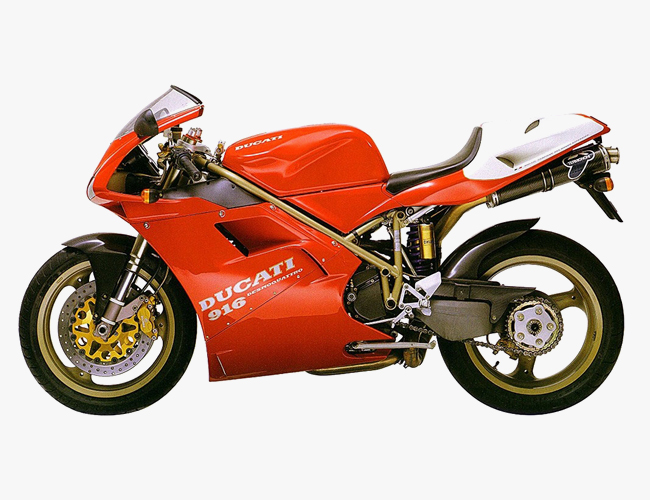
Seeking improved aerodynamics and faster tire swaps in the pits, Massimo Tamburini unwittingly penned a squinty-eyed racer with an underseat exhaust and single-sided swingarm that exuded sex — the Ducati 916. Powered by a Desmodromic L-twin engine, this new Duc was down on power compared to the Japanese inlines, but its omnipresent torque made corner exits its bitches and left everyone behind to admire a beautiful back-end. Not only did the Ducati 916 capture four of five World Superbike Championships in the late ‘90s, it also beat out Pamela Anderson for poster space on many a teenage wall. The Ducati 916 was also featured in The Art of the Motorcycle exhibit at the Guggenheim Museum. Bellissima!
Learn More: Here
Suzuki Hayabusa
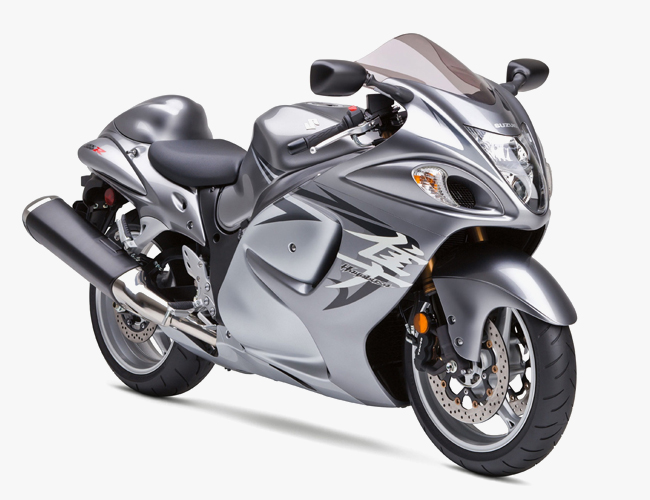
Translated, Hayabusa is Japanese for Peregrine Falcon — a bird of prey that tops 200 MPH just to snag a snack. Launched in 1999, the Suzuki Hayabusa did its namesake justice. Depending on whom you believe, the enormous dual-overhead cam, 1300cc inline-4 churned out upwards of 170 hp. That was enough to launch the 500-pound ‘Busa across the ¼ mile mark in single digits and demolish the old top speed record by 10 MPH (186 MPH). So fast and powerful was the Hayabusa that a “gentleman’s agreement” was coerced by the Western World to impede others from laying waste to future benchmarks and lives. Its aerodynamically sculpted bodywork didn’t win over everyone, but it certainly works for us.
Learn More: Here
Cagiva C593
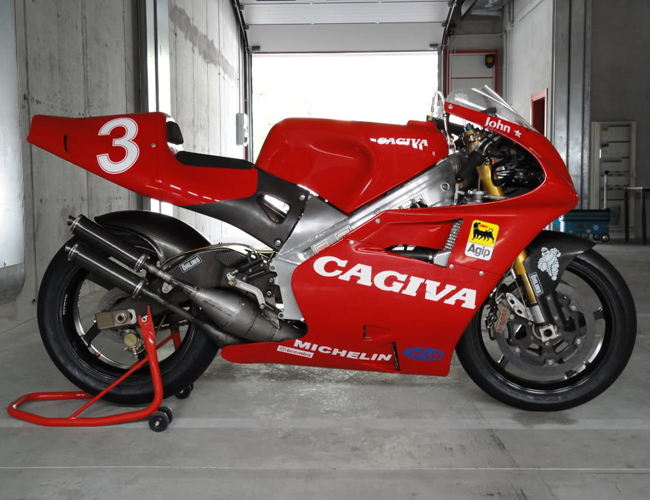
Photo: cameljockey
The 500cc Big Bang V4 found behind the veil of flame-red plastics in the Cagiva C593 could produce 175 hp and screamed to a 12,500 rpm redline. So powerful was this Grand Prix racer that Cagiva was forced to search out riders who could control the beast. Four-time champ Eddie Lawson was tapped first. Lawson notched a win in Hungary in 1992, proving the Cagiva had what it takes, but it was his feedback to engineers that proved most valuable. 1993 saw Lawson take a backseat to John Kocinski, a wild and desperate rider just looking for a contract. Kocinski would deliver two consecutive fourth place finishes to start the season before taking the checkered flag at Laguna Seca. The wins didn’t continue though. The bike was just too powerful and twitchy. Cagiva almost went bankrupt in pursuit of Grand Prix fame, but in the process showed the world what an obsessed Italian was capable of — utter madness.
Learn More: Here
Ducati Desmosedici RR
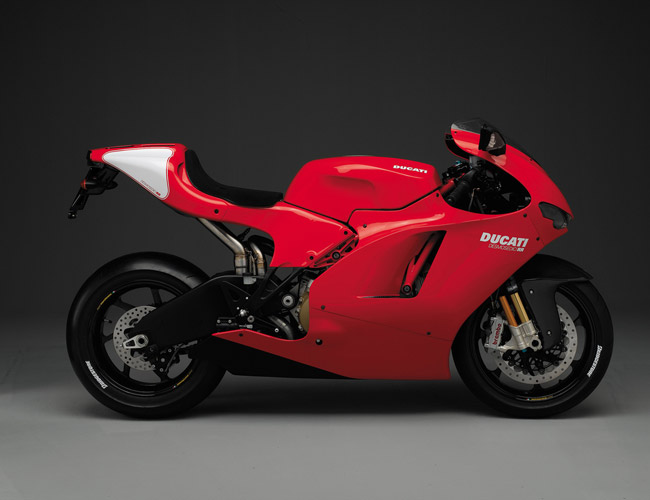
If you’ve ever dreamed of being the next Nicky Hayden, the Ducati Desmosedici RR is the bike for you. Only 1,500 models of this street-legal version of Ducati’s 2006 MotoGP entrant were produced. The all-new 200 hp, 90-degree “double-L twin” V-4 engine would scream through its vertical exits in the rear tail all the way to its 10,500 rpm redline and 194 MPH top speed. Componentry was top notch all around with Ohlins, Brembo and Marchesini put to the task of keeping riders alive and justifying the $72,500 sticker price. The Desmosedici RR is often regarded as the ultimate Ducati experience, a mechanically and aesthetically faithful reproduction of a genuine MotoGP racer — it even came with sponsorship stickers, were you so inclined.
Learn More: Here
Buell RS1200
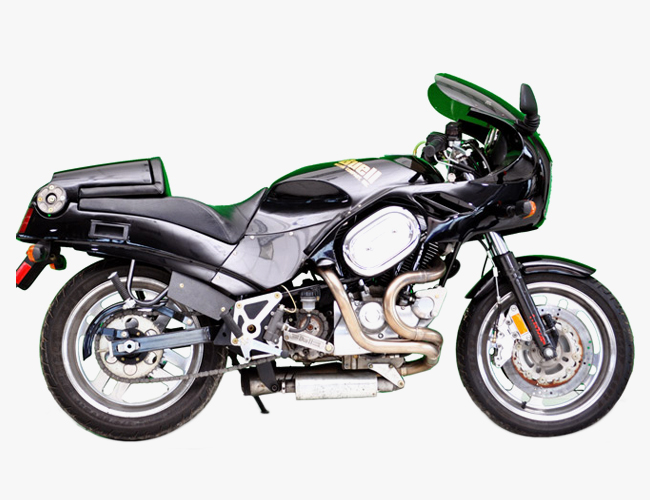
Buells were the brainchildren of Harley-Davidson engineer Erik Buell, all-American sportbikes that employed new and never-before-seen technologies and were powered by the parts-bins of Milwaukee’s Motor Company. The Buell RS1200 was a half-faired, short-wheel-based version of Buell’s first bike, the Battlewin. Now featuring Harley’s new 1200cc Sportster motor, the RS1200 cradled the power plant in its custom trellis frame, complete with rubber mounting. An underslung exhaust system (a staple of Buell bikes) and a hidden steering damper kept the center of gravity low and delivered less head movement than a dutiful dad at a Justin Bieber concert.
Learn More: Here
2009 Yamaha R1
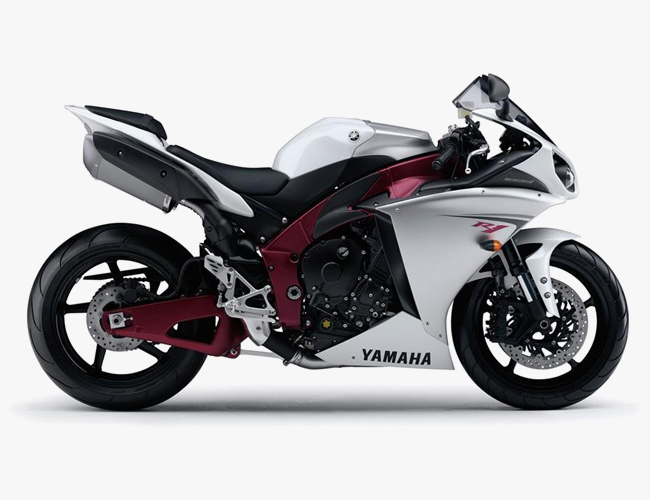
Unless you were at the track and delving into its stratospheric rev-range, a race-bred liter-bike could feel tough to ride and even underpowered. To put downsides to bed, Yamaha introduced the world to its cross-plane crankshaft fired four-pot in 2009. Delivering the torque of a twin and the power of a free-revving four, Yamaha’s new R1 used an uneven firing sequence to package two engines in one. Add to that a three-way customizable throttle map, thanks to drive-by-wire technology, and the 2009 R1 could be tailored to suit rider styles and changing conditions with the flick of a switch — making it a true go anywhere, pass everything dream machine.
Learn More: Here
Bimota Tesi 3D
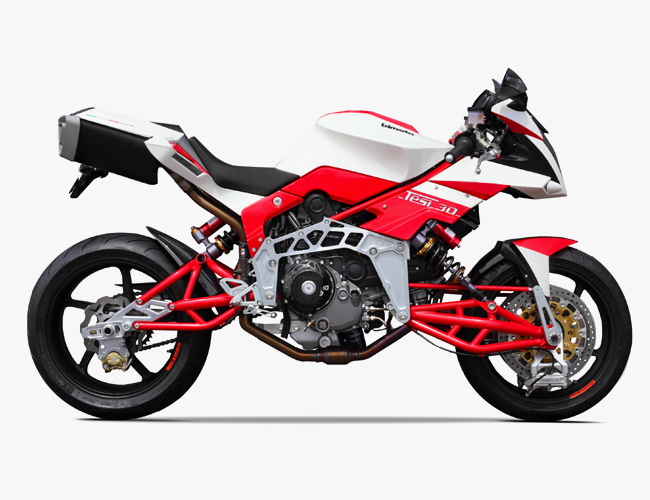
Looking for something completely different? The Bimota Tesi 3D foregoes forks in favor of a hub-centric front-end and puts its mechanicals on full display. Calling its looks utterly maniacal is an understatement. On paper, keeping braking and steering services separated by the Tesi’s tele-levers makes perfect sense, but the change in intuitive control often means the Bimota can be a beast to handle for inexperienced riders. We tend to like things that stand out in a crowd, and the fact that the Tesi sports Ducati’s sonorous V-twins only makes things better.
Learn More: Here
Suzuki TL1000R
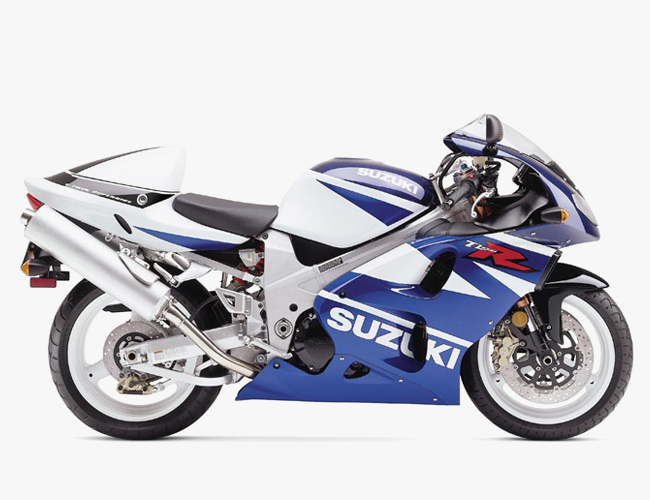
Designed to compete in the World Superbike Championship, the Suzuki TL1000R is often regarded as the Duc Hunter. Taking aim squarely at Ducati’s 916, Suzuki quickly turned R&D dollars into a fire-breathing V-Twin powered homologation special. The fully-faired “R” model featured a similar trellis-frame to the Duc but housed a 135 hp, 996cc engine renowned for its low-end torque and top-end horsepower. Although the GSX-R would take its place at the track, the TL engine lives on today.
Learn More: Here
Britten V1000
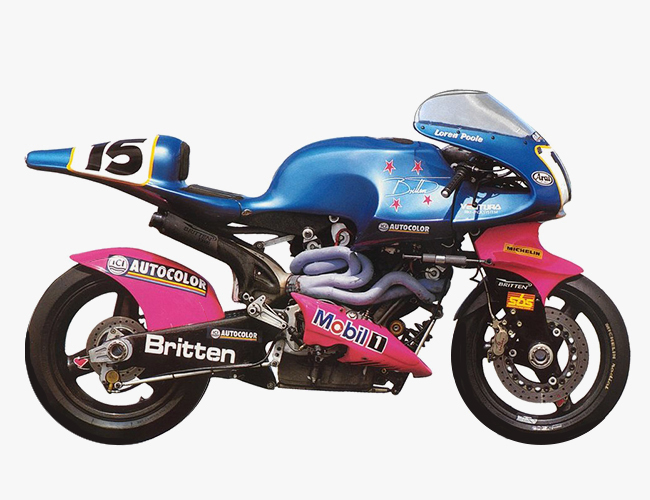
Its not often that a completely custom garage-built bike can fare well at the track. The Britten V1000, the vision of Kiwi craftsman John Britten, is one of the few that has. Not only did the V1000 take two podiums in the Battle of Twins at Daytona, it would manage to put together an impressive resume of wins and numerous world speed records throughout the early ‘90s. Ten lucky people were able to lay claim to a Britten V1000 of their own and, sadly, subsequently resigned them to mere museum duty. Such a pity.
Learn More: Here
Kawasaki Ninja H2
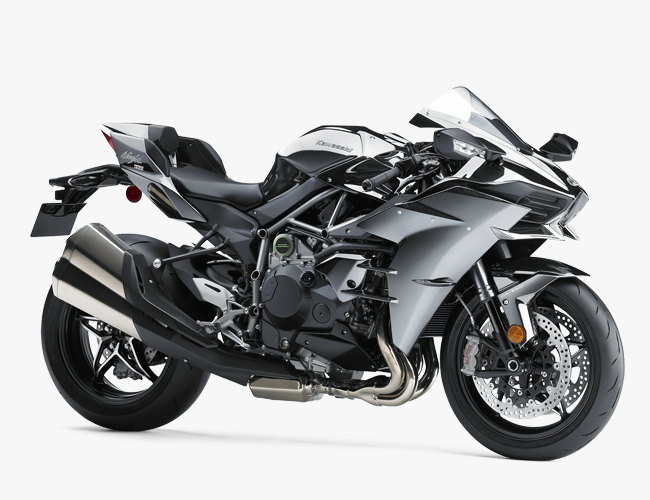
When Kawasaki Motor Co. worked with Kawasaki Heavy Industries’ aerospace and turbine divisions, what resulted was one of the fastest, most powerful production motorcycles ever built. Sporting a 998cc inline-four-cylinder and the first supercharger on a production motorcycle, the H2 makes up to 210 horsepower and hits 60 mph in 2.6 seconds. To commemorate the partnership, the River Mark logo, a badge reserved only for Kawasaki’s most historically important motorcycles, adorns the H2 along with angular and aerodynamic bodywork.
Learn More: Here
>
>
[Source : http://gearpatrol.com/2013/08/27/50-most-iconic-motorcycles/]
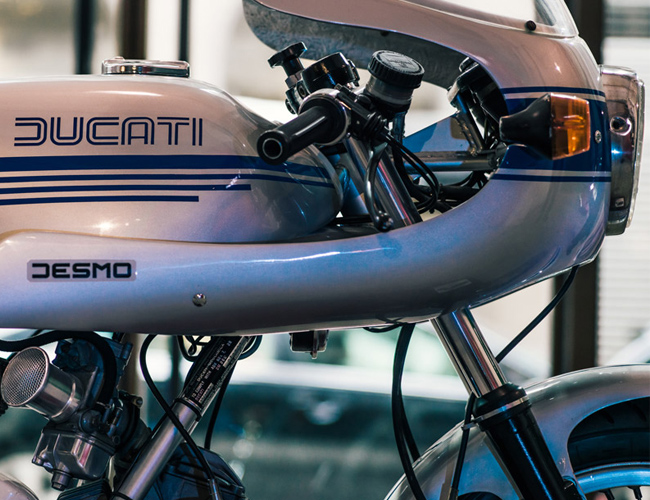
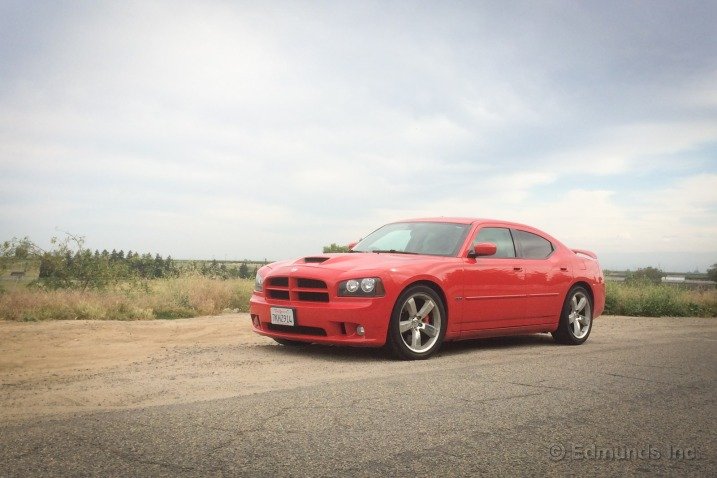
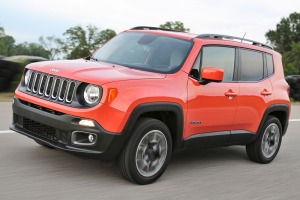


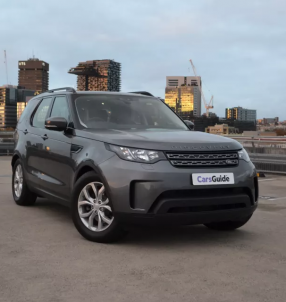
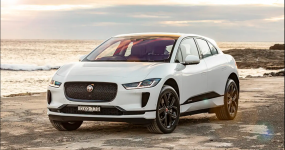
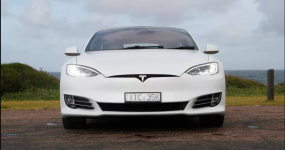
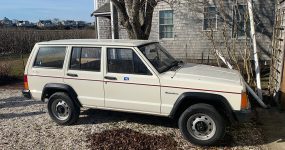
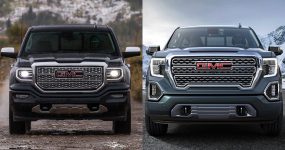
Recent Comments